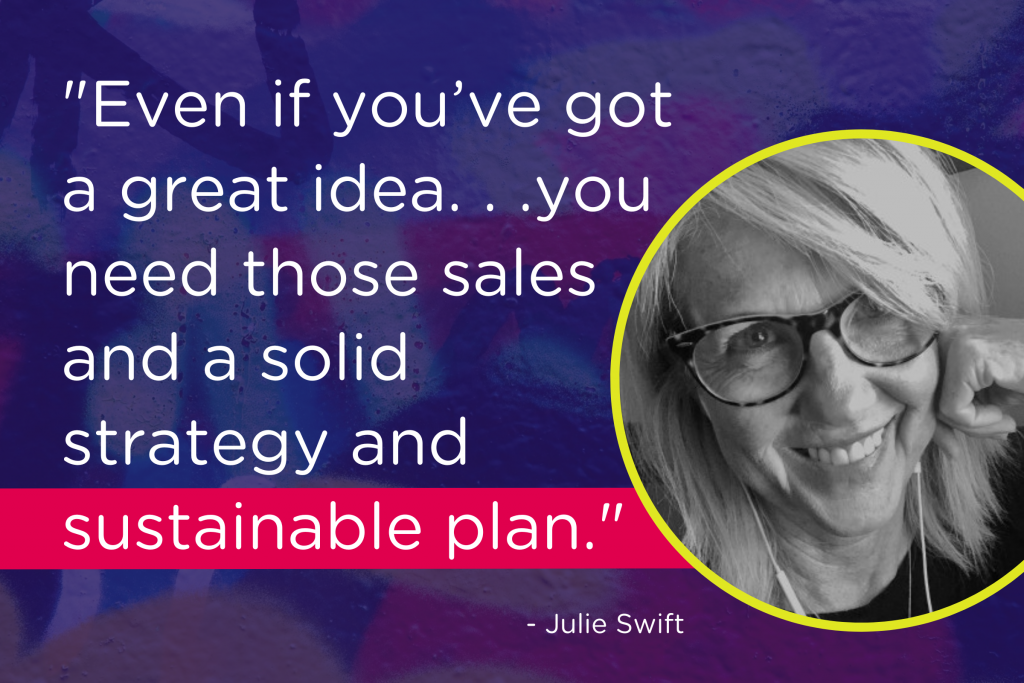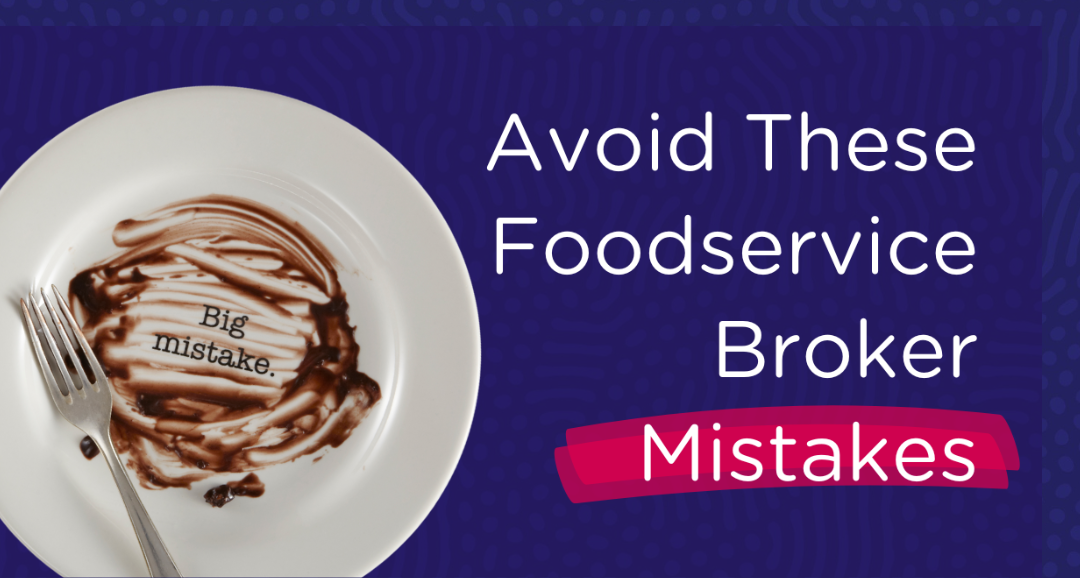You’ve got this amazing product, and you know foodservice distributors and operators will love it, if only you can get them to try it. And buy it. And sell it and buy it again. If only, you think, there were someone who could connect your product to its foodservice market. Then you hear about foodservice brokers and realize their kind of matchmaking could solve your problem!
Three of the most common kinds of new brands that approach foodservice brokers: early-stage, pre-funding startups; seed-stage startups with a round or two of funding; and channel expansion brands that have retail presence but no foodservice business.
When you go looking for a foodservice broker, you’ll want to have a rock-solid strategy and you’ll want to avoid these three most common mistakes that early-stage brands make.
“When my brand is hugely successful, my foodservice broker will profit, too.”
I’ve been on both sides of the manufacturer/broker table, and after interviewing dozens of these brands, I’ve seen three common themes.
- Some companies approach brokers almost like they’re selling watches from the insides of their trench coats. “Psst!” “You’ll want in on the ground floor of this deal!” “This is a limited offer!” “It’s going to be huge!”
- Then there’s the opposite. With their hats in their hands, almost begging, other brands know the dynamics of the broker world and just try to get someone to take a chance on them.
- And finally, still others come to brokers with the makings of a potential winner, but disorganized & lacking a solid plan.

The overriding thinking is almost always that when you – the broker — sell something, then I – the manufacturer — will pay you. Let’s walk that through. Brokers have buildings, equipment, people – you get the idea. To take on a brand with zero foodservice sales means a broker would need to deficit spend on that product’s line in order to get things moving. For simplicity’s sake, they would need to “borrow” from their paying clients to fund your brand. Not likely to happen.
So, you’ll most likely not attract a national, regional or even local independent foodservice broker with zero sales. Retainers rarely work, in addition to a myriad of other reasons that make them (with few exceptions) a bad idea. Even if you’ve got a great idea, even if you understand the dynamics of a relationship with a broker, even if you have the makings of a winner, you need those sales and a solid strategy and sustainable plan.
The good news is, if you’re willing to invest in your launch into foodservice, there are companies like ESA who get you “prime time” ready. Coming at a national broker from this modified platform brings success into the scope with brokers and offers an expedited path to market.
I can’t emphasize enough how important it is to really KNOW your brand and where the success platform lies. Rarely is the idea “it’s for everyone” a valid strategy for entrance or exponentially growing in the foodservice channel.
“We’re huge in retail! Foodservice? No problem! Exactly the same thing.”
“We’re in 140 Whole Foods stores.”
“Target just expanded their test!”
It is important that consumers love and recognize your product or brand. On the other hand, have you ever eaten at a restaurant and asked the wait staff whether the dish’s ingredients matched things you bought at the grocery store? “Great breakfast this morning! Were those the biscuits I get at Trader Joe’s?”

Yeah, I haven’t either.
You might say – foodservice directors and chefs are also consumers. They’re buying my product and using it in their kitchens at home. That may be true, BUT the decision hierarchy on whether to have your brand for dinner tonight, and the decision hierarchy to add your product to their menu is a doozy of a difference.
What’s for dinner at an operator’s home is what’s for dinner. What goes on the dinner menu at the restaurant … well, that’s a different story. That story focuses on gross margins, market appeal, menu-change costs and a host of other factors.
Foodservice differs from retail. As Stephanie Lind says, foodservice isn’t hard, but it is complicated.
“Who cares what else is in the portfolio, as long as I am!”
Have you gotten some limited sales? Identify the top brands in the broker’s portfolio that your product will complement. You’re looking for brands that will naturally sell with yours. Look closely at the top of the portfolio – ask for the top ten or fifteen products in the portfolio and understand the syndicated model.
Why this matters:
- Brokers of any size will have a syndicated sales process, with a mixed portfolio of products that sellers present to foodservice operators and distributors.
- Even if your brand is featured on a promo calendar, where sellers are required to present your product to a certain number of operators, it matters which other brands they sell alongside your product. Let me repeat that. What they sell your products with matters. You’ll get significantly more closed sales if the operator can truly “see” your product on their menu. A good seller will present that vision in an easy-to-implement package that has the operator asking – how fast can I get it?
- Think about other brands within the portfolio that line up nicely with your brand or products. You will definitely get some airtime simply by being something easy to sell with their other brands. In those times when a complementary brand lands on the promo calendar, you’ll be the brand they know to easily sell alongside that promoted product.
- Keep in mind, sellers decide what they will sell with featured promos each quarter or trimester, and they also make day-to-day selling decisions, to their regular customers. If you’re a fit, and you lay that out nicely up front, you’ll once again naturally gain more airtime and therefore more sales.
Oh, and even if the foodservice operator is convinced, will the distributor stock it? If they stock it, will it be open-coded?
Train to these synergies. If sellers buy in to the way your product fits with others in the portfolio, they’ll present it again and again. I know it’s hard to think about spending valuable airtime with sellers in training on anything but your own brand or product. However, three-dimensional training that takes into consideration other partners within their line will not only resonate with sellers, but your overall partnership will benefit greatly from it.

And lastly, as a bonus, here’s one more trap to avoid.
“I got the cheapest price and the best deal!”
You get what you pay for in a lot of cases, and that certainly holds true in relationships like the one you want with your foodservice broker. The value of a true partnership derives synergy well beyond the sum of its equal parts. Beginning your relationship with the sense that you’ve convinced the other party to undervalue their services … well, that doesn’t exactly set you up for success.
Have a realistic understanding and estimate of the true cost to serve and represent your business, knowing that every brand is a bit different. We expand on this in the fourth article in this series, but for now, keep in mind that you’re building a cooperative relationship. Your broker has expenses and is in the business to make a profit, just like you are.
The truth is, maybe you CAN get it for less, but what will you get, and what will you miss? If you know you pay less than other brands, how can you expect the same level of service? What if, instead, you paid more, and also expected more? You’re likely to get it.
Choosing the right broker can mean the difference in your brand’s foodservice success. To have the best choices of brokers, you must prepare and be ready to make the most of your relationship. Begin with the right attitude and expectations, the right strategy and sales (with help from a company like ESA), the right understanding of the synergies of a syndicated portfolio, and the right respect for your broker partner. With those lined up, you’ve set your brand up to find the right broker and to make a splash in the foodservice world.

Our guest blogger for this five-part series is Julie Swift. Julie provides us with a unique perspective, as a person who’s spent thirty years in foodservice, with time on each side of the client-broker relationship.
Julie spent 25 years in sales and marketing for the French’s Food Company and McCormick, and then just over 4 years as a broker in senior & executive leadership roles across sales, marketing, digital & business development. She has interviewed over 100 potential manufacturers – she knows what she’s talking about! Visit her or find her on LinkedIn


Recent Comments